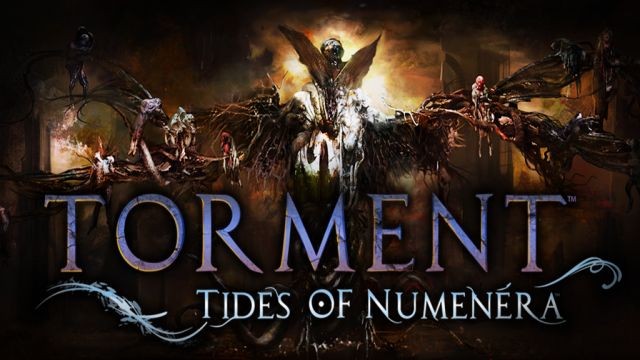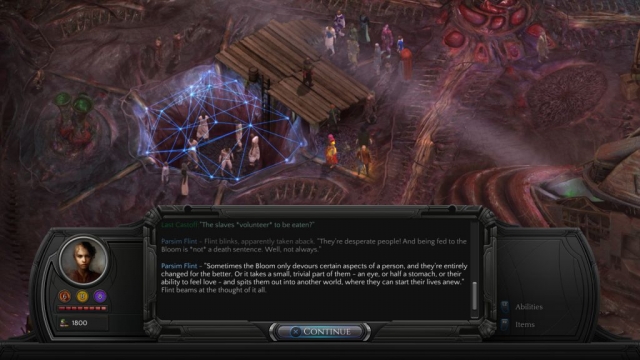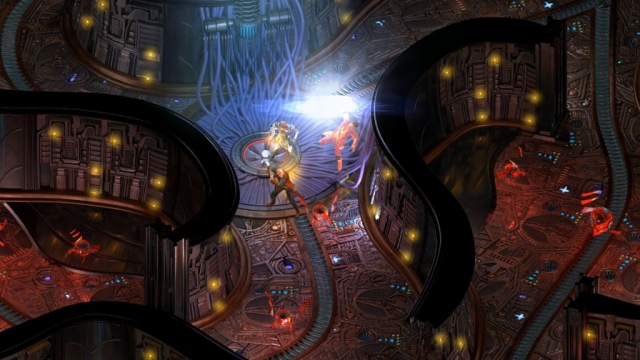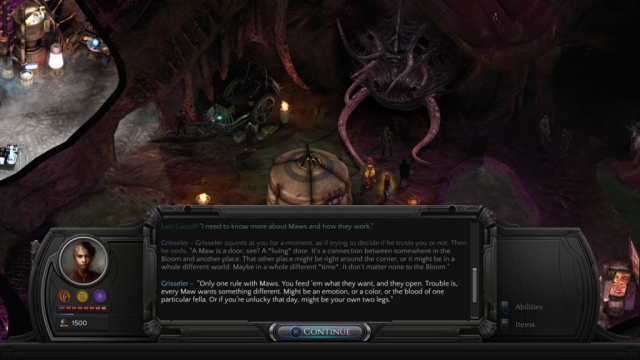Torment: Tides of Numenera

Two things I should probably get out up front. One, I spent an inordinate amount of my teenage years and even up into graduate school playing D&D and a slew of its variants. Groups of guys sitting around a table on Saturday afternoons, pads of graph paper (mechanical pencils, which were new inventions!), big bags of dice – I’ve done a metric crapton of that. Two, I never played Planescape: Torment (which came out in 1999), and had only vaguely heard of it recently when a Kickstarter campaign funded this thematic successor, despite being a guy who plays lots and lots of RPGs on the computer. So there’s that out of the way.
Anyway, all that said, I really don’t know what to make of Torment: Tides of Numenera (T:ToN). It has more reading than a text adventure, more multiple choice questions than an SAT exam, has more baffling machinery and doodads lying around than Myst, and what feels like more meandering and backtracking than a Family Circus comic strip. Beyond the graphics, which are pretty nice and based on the same engine as Pillars of Eternity, the whole thing plays like it fell out of the late 1990’s, like some kind of choose-your-own-adventure novel. I think they’re trying to recreate some of the feelings and adventure of my D&D sessions. It, for me at least, failed for a whole slew of reasons, but before I dig into those, let me take a moment to describe this game.
The world is set in what is called the ninth age, which implies that eight advanced civilizations have existed in the past but have collapsed for various reasons, and each new one builds upon the wreckage and tchotchkes (the game calls them numenera) of the previous ones. The society of today is kind of medieval, but pieces of technology – robots, perplexing power generators, force shields, body augmentations – still exist in various states of disrepair. Magic in this world is just the application of lost and misunderstood technologies. The playing field is third-person isometric. In what feels like an extremely dated game mechanic, the game is broken into delineated play areas. You wander around an area, such as a village market for example, talking to people and interacting with objects, and when you’re done in that area you cross a bridge, or enter a tunnel, or climb down a ladder, and another area loads up and you wander around there. I spent an inordinate amount of time going back and forth between areas to close out quests. Character generation is in line with what we’ve all seen in these games – there’s a warrior, a thief, a mage, and you can mix and match skills from each class to customize your character. There is no alignment system exactly, though as you make choices in the game you are given messages like “Red tide rises slightly” which, if I knew what the heck the colors meant, I think serves the same purpose. As long as I’m referencing a game from 1999, I might as well play an ‘I’m older than you’ card by bringing up that the whole thing feels like the Virtues from Ultima 4, which was released back in 1984. Press materials specifically point out that most combat can be avoided with dialog. Whew, they weren’t kidding. There’s a brief combat right at the beginning to get you familiar with the combat system, and then I didn’t see combat – didn’t even see the opportunity for combat – for seven more play hours. By the time I had gotten back to combat, I had completely forgotten that first tutorial. That’s not exactly a complaint. Not all of my games have to feature killing things, but I do have a lot of other complaints which I promised you earlier, and I should probably get to them now.
One, a guy named Kelly used to bring a bag of Cheetos the size of a Volkswagen to the gaming sessions in graduate school – I have no idea where he even bought it. This was back way before Sam’s Club existed. And another guy named Greg always had his satchel of something like 100 d6 dice. He loved combat systems that required rolling big handfuls of d6 dice, like he was at the craps table in Vegas, the huge clatter of all those cubes hitting the tabletop. So point one is that those sessions were all about the human interaction and the personalities involved: the quirky guy with his lucky D&D socks, the guy who played chaotic characters just to tweak the DM, the guy who always insisting on playing female characters, probably due to a gender confusion issue (OK, I admit that was me). The closer a PC game tries to recreate those days, the more I become cognizant of the fact that I’m playing alone, and I’ve got no Cheetos.
Two (and maybe this should have been point number one because it is more important), as a game tries to allow me to forge my own path, makes as its central tenet by trumpeting how much choice a player has in the outcomes of the morale choices they face, inevitably I find myself chafing without the choices I really want to make. If a game is going to restrict me to deciding if some character lives or dies, I’m fine with that limited branching. If a game tells me instead that I have complete freedom to choose the outcome, but then gives me maybe four specific options, I feel more hemmed in and disappointed by that structure. Also, and this complaint is more specific to T:ToN, I started out knowing so little about the world in which I found myself and my own character, that I never really grasped the implications of the decisions I was making. Early on the game, I have the option of telling people I am a castoff of the changing god. Do you know what that means? Me neither. So I had no idea how people would react to such news, let alone how I wanted them to react, and technically I wasn’t even sure I was a castoff of the changing god. So, sure, I’m the changing god thingy, or I’m not, believe me, or don’t. I don’t know. I don’t care! I made choices more or less at random, clicking through the dialog trees, unmotivated by characters or outcomes, just looking for some kind of tree closure.
Three (and probably this should be two, with the point I made first in third place), developing a plot as convoluted as T:ToN takes exposition, a boatload of it. In ye olde time of D&D, this was transmitted through a technique, all but lost today, our own little numenera, called conversation. Back and forth, around the table, guys cracking jokes, the DM shaking his head sadly, your overall knowledge of the world develops organically. T:ToN has some spoken dialog, and then something like a thousand pages of text. The way the game actually plays is that you walk up to a character, just some person standing in a public market, and talk to them. Sometimes they’re nobody, just a faceless NPC passing the time, and a thought balloon appears which says “Nice day today!” or something to that effect, but sometimes there would be like a muffled clap sound (significant character interaction approaching!) and the screen would center on you and this character, and I’d think to myself “Oh, here comes some more text,” and there would be a couple of paragraphs of text, and then some choices as to your response at the bottom, which would lead to more text, more choices, more text, up and down the decision trees. Saying this even as a guy who on the whole enjoys reading, there is a lot of reading in this game, which, bluntly, became utterly exhausting as the hours rolled on.
Look, there’s no point in beating a dead horse. If you contributed to the Kickstarter based on fond memories of Planescape: Torment you might well be fine with Torment: Tides of Numenera which, from my reading about P:T, sounds a whole like the same game set in the same universe with a new plotline and improved graphics. But for me, who since 1999 has played games like Neverwinter and Pillars of Eternity and a whole host of more immersive RPGs in between, I failed to get into it. I skipped lightly along the plot, confronted by moral and ethical choices I for the most part either didn’t understand the implications of or didn’t care enough about. Interviews I have read with the designers indicated they wanted players to consider the question “What does one life matter.” This game didn’t make me consider that. It did make me consider what a dozen or so hours of my life are worth, and this wasn’t it.
Reviewed By: Phil Soletsky
Publisher: Techland Publishing
Rating: 60%
——————————————————————————–
This review is based on a digital copy of Torment: Tides of Numenera for the PC provided by Techland Publishing.
 Game Over Online
Game Over Online














Completely agree, unfortunately. I remember the days when people complained and wanted to move past Infinity style games. Fallout 1&2, Bladur’s Gate I & II & Planescape: Torment are still some of my favorite games of all time. But, there was real passion & talent behind those games.
This new Planescape game just bored me to tears (and almost all of the other throwback games). If only Black Isle could get back together as 20 year old somethings and hash out a new game in an upgraded engine…)
This isn’t set in the same universe/setting as planscape and is in no a way an actual sequel. Saying Planescape fans would like this is a total joke lol.